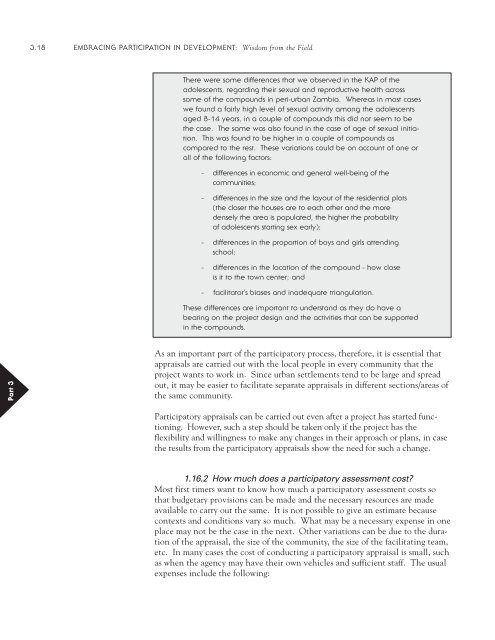PRA-Manual Embracing Participitation tools-only.pdf - PACA
PRA-Manual Embracing Participitation tools-only.pdf - PACA
PRA-Manual Embracing Participitation tools-only.pdf - PACA
You also want an ePaper? Increase the reach of your titles
YUMPU automatically turns print PDFs into web optimized ePapers that Google loves.
3.18 EMBRACING PARTICIPATION IN DEVELOPMENT: Wisdom from the Field<br />
There were some differences that we observed in the KAP of the<br />
adolescents, regarding their sexual and reproductive health across<br />
some of the compounds in peri-urban Zambia. Whereas in most cases<br />
we found a fairly high level of sexual activity among the adolescents<br />
aged 8-14 years, in a couple of compounds this did not seem to be<br />
the case. The same was also found in the case of age of sexual initiation.<br />
This was found to be higher in a couple of compounds as<br />
compared to the rest. These variations could be on account of one or<br />
all of the following factors:<br />
- differences in economic and general well-being of the<br />
communities;<br />
- differences in the size and the layout of the residential plots<br />
(the closer the houses are to each other and the more<br />
densely the area is populated, the higher the probability<br />
of adolescents starting sex early);<br />
- differences in the proportion of boys and girls attending<br />
school;<br />
- differences in the location of the compound - how close<br />
is it to the town center; and<br />
- facilitator’s biases and inadequate triangulation.<br />
These differences are important to understand as they do have a<br />
bearing on the project design and the activities that can be supported<br />
in the compounds.<br />
Part 3<br />
As an important part of the participatory process, therefore, it is essential that<br />
appraisals are carried out with the local people in every community that the<br />
project wants to work in. Since urban settlements tend to be large and spread<br />
out, it may be easier to facilitate separate appraisals in different sections/areas of<br />
the same community.<br />
Participatory appraisals can be carried out even after a project has started functioning.<br />
However, such a step should be taken <strong>only</strong> if the project has the<br />
flexibility and willingness to make any changes in their approach or plans, in case<br />
the results from the participatory appraisals show the need for such a change.<br />
1.16.2 How much does a participatory assessment cost?<br />
Most first timers want to know how much a participatory assessment costs so<br />
that budgetary provisions can be made and the necessary resources are made<br />
available to carry out the same. It is not possible to give an estimate because<br />
contexts and conditions vary so much. What may be a necessary expense in one<br />
place may not be the case in the next. Other variations can be due to the duration<br />
of the appraisal, the size of the community, the size of the facilitating team,<br />
etc. In many cases the cost of conducting a participatory appraisal is small, such<br />
as when the agency may have their own vehicles and sufficient staff. The usual<br />
expenses include the following:














